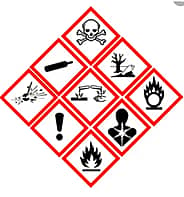
On February 16, 2021, the Occupational Safety and Health Administration (OSHA) published a Notice of Proposed Rule Making (NPRM) to amend the Hazard Communication Standard (HCS). The current HCS was last updated in 2012 to align the standard with the third revision of the United Nations (UN) Globally Harmonized System of Classification and Labeling of Chemicals (GHS). The proposed changes are to update the HCS to align it with the seventh revised edition of the GHS.
Highlights of the proposed changes include:
Definitions
- Updates to three existing definitions (exposure/exposed, hazardous chemical, physical hazard)
- Addition of eight new definitions (bulk shipment, combustible dust, gas, liquid, solid, immediate outer package, physician or other licensed health-care professional (PLHCP), and released for shipment)
Hazard Classification
- Clarification that the hazard classification has to consider both normal considerations of use and foreseeable emergencies
- Additional requirements that the hazard classification must include any hazards associated with a change in the chemical’s physical form or resulting from a reaction with other chemicals under normal conditions of use
- Changes to Appendix A, Health Hazard Criteria including revised health hazard definitions and significant revisions to the sections on skin corrosion/irritation and serious eye damage/irritation
- Changes to Appendix B, Physical Hazard Criteria, including changes to the flammable gases hazard class, expansion of the flammable aerosol hazard class, and a new physical hazard class for desensitized explosives
Labeling
- Additional requirements that the label includes the date a chemical is released for shipment (OSHA’s position is that this would allow manufacturers and distributors to more easily determine their obligation to update labels when new hazard information becomes available)
- Modification of the requirement that manufacturers, importers, or distributors who become aware of significant information on the hazards of a chemical have to update the label within 6 months (to account for the long distribution cycle and the hazards that may be associated with relabeling chemicals that have already been prepared for shipment, OSHA is proposing that chemicals that have been released for shipment and awaiting distribution need not be relabeled; however the updated label for each individual container must be provided with each shipment)
- Accommodations to allow for limited information on small container labels based on the size of the container; however full labeling is required on the outside packaging
Safety Data Sheets
- Content revisions were proposed for some of the 16 SDS sections. For instance, in Section 9, Physical and Chemical Properties, odor threshold and evaporation rate no longer need to be included, but particle characteristics do
Pictograms
- Desensitized explosives are now included in the flame pictogram
- Hazards not otherwise classified (HNOC) have been added to the exclamation point pictogram
Trade Secrets
- An allowance for concentration ranges to be claimed as a trade secret has been added; however, the ingredient’s concentration range must be selected from a prescribed list of range options and the narrowest range has to be included on the SDS
What hasn’t changed?
Among other provisions of the standard that have remained unchanged, there are no proposed changes to the requirement to have a written Hazard Communication Program. In addition, the content requirements of the written program remain the same.
There were also no proposed changes to employee information and training requirements. Although there were some proposed SDS content changes as mentioned above, there were no proposed changes regarding the chemical manufacturer, importer, or distributor obligations to provide SDS and employer obligations to maintain them.
OSHA is proposing to implement the revised provisions over a two-year phase-in period. Chemical manufacturers, importers, and distributors evaluating substances will have one year after the effective date to comply with all modified provisions of the HCS. Chemical manufacturers, importers, and distributors evaluating mixtures will have to comply with all modified provisions no later than two years after the effective date. The notice of proposed rulemaking is open for comments until April 19, 2021.
A complete description of the proposed changes has been published in the Federal Register and a marked-up version of the text of the current HCS is also available. For additional information on the proposed changes and how they might affect your business, please email [email protected].
This blog was written by Beth Graham, our Associate Director of Quality, Research, and Training who has been with Safety Partners Inc. for the last 11 years.
